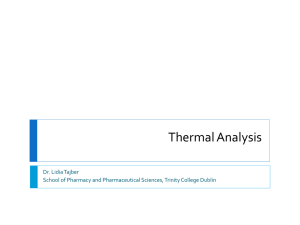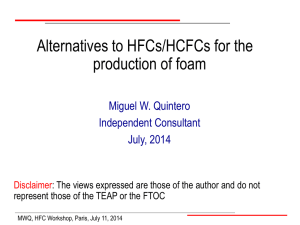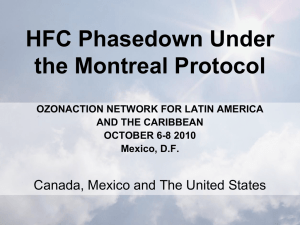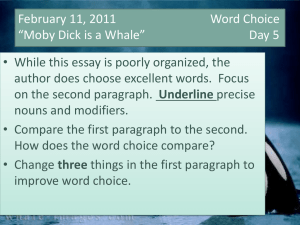kinetics-thermal-aging-HFC-presentation
advertisement
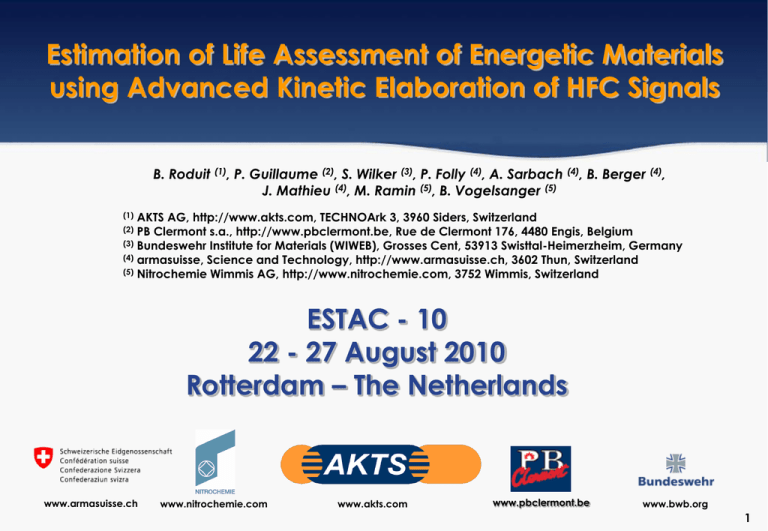
Estimation of Life Assessment of Energetic Materials using Advanced Kinetic Elaboration of HFC Signals B. Roduit (1), P. Guillaume (2), S. Wilker (3), P. Folly (4), A. Sarbach (4), B. Berger (4), J. Mathieu (4), M. Ramin (5), B. Vogelsanger (5) AKTS AG, http://www.akts.com, TECHNOArk 3, 3960 Siders, Switzerland PB Clermont s.a., http://www.pbclermont.be, Rue de Clermont 176, 4480 Engis, Belgium (3) Bundeswehr Institute for Materials (WIWEB), Grosses Cent, 53913 Swisttal-Heimerzheim, Germany (4) armasuisse, Science and Technology, http://www.armasuisse.ch, 3602 Thun, Switzerland (5) Nitrochemie Wimmis AG, http://www.nitrochemie.com, 3752 Wimmis, Switzerland (1) (2) ESTAC - 10 22 - 27 August 2010 Rotterdam – The Netherlands www.armasuisse.ch www.nitrochemie.com www.akts.com www.pbclermont.be www.bwb.org 1 DSC TG The precise prediction of the degradation of materials HPLC HFC CL 2 Exo TG DSC HeatFlow (W/g) 8 6 4 Heat : -121.682 (J/g) 2 0 -2 150 160 . 170 180 190 200 Temperature (°C) 210 220 230 The precise prediction of the degradation of materials HPLC HFC CL 3 More precise measurement of the thermal aging of energetic materials -Applications of isothermal microcalorimetry (HFC) 4 Exo TG DSC HeatFlow (W/g) 8 6 4 Heat : -121.682 (J/g) 2 0 -2 150 160 . 170 180 190 200 Temperature (°C) 210 220 230 The precise prediction of the degradation of materials HPLC HFC CL 5 Exo TG HeatFlow (W/g) 8 6 4 DSC Heat : -121.682 (J/g) 2 0 -2 150 . 160 170 180 190 200 Temperature (°C) 210 220 230 The precise prediction of the degradation of materials HPLC CL 6 Experimentally : Just few temperatures 7 reaction progress APPLICATION OF HFC The use of HFC enables to gain advanced knowledge on the reaction rate at the early stage of the decomposition experiments ? 0%<a<5% temperature T1 T2 T3 predictions time 50°C < T < 100°C days < t < months 8 Reaction rate Well defined 50°C Reaction progress Because baseline is well defined Well defined 7 years ! 9 Isoconversional methods Uncertainity of thermokinetic analysis : the stages and physico-chemical reaction pathways are generally unknown 2.75 Exo ? 2.5 2.25 2 HeatFlow |-bs (W/g) What do you see below? Young women? Old man? Or both? 1.75 1.5 1.25 1 0.75 0.5 0.25 0 200 220 3-Methyl-4-nitrophenol_DSC_dyn_2G 240 260 Temperature (°C) 280 300 Observed thermal event can be the sum of thermal events created during certain stages of the reaction which are not always known 10 Isoconversional method Isoconversional methods (model free): Three main modifications of isoconversional method are applied in the literature: - Differential (Friedman) - Integral (Flynn-Ozawa-Wall) - Advanced integral based on non-linear procedure (Vyazovkin) Differential isoconversional method Reaction rate expressed by the Arrhenius equation = Reaction rate at a given reaction progress a is only a function of the temperature A’(a) and E(a) are the pre-exponential factor and apparent activation energy 11 activation energy E /kJ·mol^-1 Activation energy E as a function of the heat release 160 A 150 140 Ea = 138 kJ/mol 130 120 110 100 0.1 1 10 heat release Q /J·g^-1 100 1000 12 THERMAL AGING heat flow /W·g^-1 1.E-03 Ia 89°C 80°C 1.E-04 70°C 1.E-05 60°C 50°C 1.E-06 40°C 1.E-07 30°C 1.E-08 10°C 1.E-09 0.0001 0.001 0.01 0.1 time /year 1 10 20°C 100 13 THERMAL AGING heat release /J·g^-1 1000 Ib 89°C 100 80°C 70°C 60°C 50°C 40°C 30°C 10 20°C 10°C 1 0.1 0.01 0.001 0.01 0.1 1 10 100 time /year 14 Beijing 60 temperature /°C 50 40 30 20 STANAG 2895 A2 (Hot dry) 10 0 0 2 4 6 8 10 time /year 15 = The assumption that the reaction rate da/dt at a given reaction progress a is only a function of the temperature (differential isoconversional analysis) is acceptable. It can be applied for a precise life assessment of energetic materials16 Conclusion (a ± 0.1%) very precise predictions long term predictions fast experiments (<10 hours) ? Exo HeatFlow (W/g) 8 6 4 (>1 year) Heat : -121.682 (J/g) 2 0 -2 150 . 160 170 180 190 200 Temperature (°C) DSC 210 220 230 HFC 17 Conclusion (a ± 0.1%) very precise predictions fast experiments (<10 hours) long term predictions (>1 year) If you want to perform fast experiments (DSC) and get long term predictions using thermokinetics do not expect very precise predictions. If you want to perform fast experiments (DSC) and get very precise predictions using thermokinetics do not expect long term predictions. If you want to achieve long term predictions and expect very precise predictions using thermokinetics do not perform fast experiments (DSC). Do long term isothermal microcalorimetric measurements (HFC) and perform thermokinetics. 18 Conclusion (a ± 0.1%) very precise predictions long term predictions fast experiments (<10 hours) ? Exo HeatFlow (W/g) 8 6 4 (>1 year) Heat : -121.682 (J/g) 2 0 -2 150 . 160 170 180 190 200 Temperature (°C) DSC 210 220 230 HFC 19 Acknowledgements Our partners and friends Thank you for your attention For more information: www.akts.com 20 Advanced Kinetics and Technology Solutions


